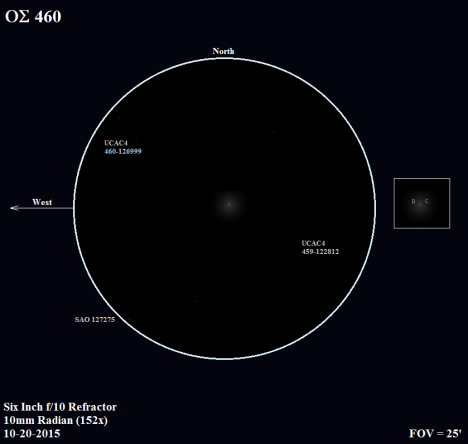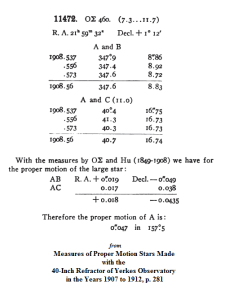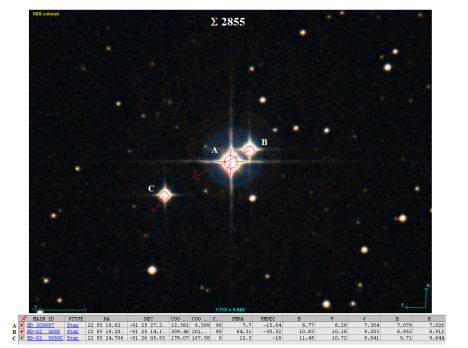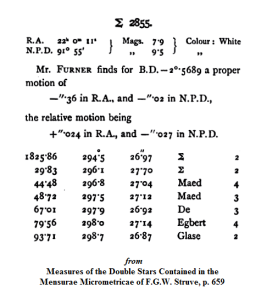If it seems like we’ve been here before, it’s because we have – just a month shy of a year ago, when we looked at “The Alpha-Beta-Gamma of Aquarius,” and discussed Homer-era Greek grammarians, urns of olives, and wine. Those who believe double star discussions have to be relegated to dry recitations of arrid statistics haven’t spent a night with a few ancient Greek star gazers.
On that trip, we discovered Sadalmelik, aka Alpha (α) Aquarii, means “lucky stars of the king”. Some of that luck seems to have spread to a few nearby stars in the rarified void surrounding Sadalmelik (we’re outside the Milky Way here, so star populations are sparse). I accidentally stumbled over the first lucky star, a tantalizing triple, while surveying some of Herr Otto Wilhelm von Struve’s more difficult discoveries, and it didn’t take long to discover his father, Friedrich Georg Wilhelm von Struve, had also found a couple of visually stunning stars. All three of the stars we’re about to look at are within a two degree radius of Sadalmelik, which will serve as our star base.
Aquarius is a dim and meandering constellation spread out over several acres of sky. You’ll find it below the west edges of Pegasus and Cetus and north of Capricornus. Focus your attention on the turquoise α (Alpha) in the chart above because we’re not going to wander far from it.
Here are the locations of our three stars, all labeled in tempting turquoise:
We’ll going to start in the north and work our way south, so let’s move north to OΣ 460, which is located two degrees due north of Sadalmelik. Use 7.57 magnitude HIP 109044 and 6.99 magnitude HIP 109052 to point you in the correct direction. You’ll find OΣ 460 lying in the center of a dim, but distinctive arc of three stars; 7.24 magnitude HIP 109144 lies on its east side, and 8.39 HIP 108990 brackets it on its west side.
OΣ 460 (STT 460) HIP: 109064 SAO: 127283
RA: 22h 05.7m +01° 47’
Magnitudes AB: 8.40, 12.80 AC: 8.40, 12.10
Separations AB: 13.80” AC: 18.80”
Position Angles AB: 340° (WDS 2003) AC: 30° (WDS 2003)
Distance: 867 Light Years (Simbad)
Spectral Classification: “A” is F0
After several frustrating attempts to split some uncooperative sub-arcsecond pairs, I went in search of this tantalizing triple star as a diversion. My first glance into the eyepiece showed a single star, but when I averted my vision slightly, both “B” and “C” suddenly materialized from out of the primarial glare, which, after wrestling with stars that refused to separate, was a very welcome sight:

Averted vision beauty! You have to look closely to catch sight of the “B” and “C” components, just as I did when peering into the eyepiece. The primary is a weak shade of white. Notice the two UCAC4 labeled stars, which we’ll come back to shortly. (East & west reversed to match the refractor view, click on the sketch for a better view of the faint components).
I doubled the magnification with a 5mm eyepiece in hopes of pulling “B” and “C” out of the subdued glare of the primary, which resulted in this slightly improved view:

Although they’ve moved up to direct vision objects, you still have to look closely to catch “B” and “C”. (East & west reversed once again, click to improve the view).
At 304x, I was able to confirm my 152x impression that both “B” and “C” are brighter than the magnitudes shown above from the WDS. Even though it was an averted vision object at 152x, “B” was too conspicuous in my six inch refractor for a 12.8 magnitude star, especially considering it’s parked within 14” of a primary listed as being four magnitudes brighter. In fact, when compared with the two UCAC4 labeled stars in the first sketch (here it is again), both of which are in the 11.2 to 11.4 magnitude range, “B” was of about the same brightness, allowing for the glare of the primary. I found “C” was slightly brighter than “B”, perhaps in line with the .7 WDS magnitude difference between them, suggesting a magnitude for C in the range of 10.6.
A quick look at the excerpt above at the right from S.W. Burnham’s 1913 Proper Motion Catalog shows he estimated the magnitude of “B” at 11.7 and “C” at 11.0, which is similar to my estimates. STT 460 is part of a joint survey of Otto Struve’s pairs with high magnitude differentials (delta_M) I’m working on, so it will eventually be suggested to the WDS for magnitude revisions.
A glance at the proper motion of the three stars of OΣ 460 shows they appear to be unrelated, since all three are moving in different directions and at differing rates of speed.
A: +036 -040 (WDS) (.033”/year east, .038”/year south)
B: -031 +142 (WDS) (.031”/year west, .142”/year north)
C: +027 +001 (WDS) (.027”/year east, .001”/year north)
Now we’ll drop down to Σ 2862, which lies a bit more than a degree (1° 16’) south and very slightly east of OΣ 460. You’ll find it just 24’ east of 6.99 magnitude HIP 109052. (Here’s our previous chart again).
Σ 2862 HIP: 109186 SAO: 127306
RA: 22 07.1m Dec: +00° 34’
Magnitudes: 8.04, 8.41
Separation: 2.5”
Position Angle: 95° (WDS 2011)
Distance: 256 Light Years (Simbad)
Spectral Classification: “A” is F8
Spare beauty in a sparse field is the best way to describe this delicate pair:

The primary and secondary are white, almost touching one another, separated by the width of B. It always amazes me how frequently surrounding stars arrange themselves into eye-catching geometric configurations – notice the three stars pointing into the west, lined up almost perfectly with one another. The moon was at first quarter when I made this sketch, about 40 degrees to the west, with moisture practically dripping out of the air, so some of the background stars undoubtedly were obscured at the time. (East and west reversed once more, click to improve the view considerably).
This pair of stars was discovered and measured in 1828 by F.G.W. Struve. The WDS identifies it as a physical double, which appears to be based on the similar proper motions of the two components. The WDS data shows “A” with a rate of +078 +049 (.078”/yr east, .049”/yr north) and “B” with a rate of +088 +047 (.088”/yr east, .047”/yr north).
Shown below is a list of measures in Thomas Lewis’s book on Struve’s stars, to which I’ve added two additional measures that I pulled from S.W. Burnham’s 1906 catalog (labeled LM and Hu), three from R.G. Atiken’s 1932 catalog, and four which come from WDS data.
Based on the proper motion of the two stars, there should be very little detectable change in the relative positions of the two components. The separation measures in the list above are relatively stable in the 2.3” to 2.5” range, but surprisingly the position angle has consistently moved in a northward direction. That would lead to the conclusion that either the proper motions numbers are slightly off, or that that one of the two stars could be in a very wide orbit around the other. Some of the preliminary GAIA data is available now in Vizier (the catalog code is I/324) so I checked and found that, unlike the WDS, it lists both stars with the same proper motion, +088.7 +046.6, numbers which are at least similar to the WDS. At any rate, it’s possible these two stars are doing something more than just traveling the through the galaxy in tandem.
Our last star lies a little over a degree (1°7’) south of Sadalmelik (our chart once again). Drop a short 38’ south and slightly west to 5.29 magnitude 32 Aquarii and then another 32’ south and slightly east to reach Σ 2855, using 9.21 magnitude SAO 145857 to guide you. Notice Σ 2855 forms a triangle with two faint stars, 8.51 magnitude HIP 109141 and 8.93 magnitude SAO 145864.
Σ 2855 (STF 2855) HIP: 109038 SAO: 145859
RA: 22h 05.3m Dec: -01° 25’
Magnitudes AB: 8.34, 10.26 AC: 8.34, 10.80
Separations AB: 25.10” AC: 85.10”
Position Angles AB: 305° (WDS 2013) AC: 117° (WDS 2013)
Distances A: 494 Light Years B: 109 Light Years
Spectral Classifications: “A” is F8, “B” is G
Spare beauty once more, but we also find ourselves entranced again by a captivating geometric configuration:

The primary was a faint white, and easily the brightest star in a sparse field, while “B” and “C” seemed to be intent on getting lined up perfectly. The first quarter moon mentioned above also had something to do with the lack of stars seen in the field. (East & west reversed once more, click for a much better view).
F.G.W. Struve discovered the AB pair in 1828, and I haven’t been able to track down who added the “C” component in 1896. S.W. Burnham would have been the most likely person, but he didn’t include it in his 1906 or 1913 catalogs, and from what I can determine, Philip Fox and George Hough didn’t measure it either. I had hoped to get a clue from Aitken’s 1932 catalog, but for some reason he skipped over Σ 2855 entirely.
A look at the distances shown above in the next to last line of data eliminates any question as to whether the AB pair are related, since there’s approximately 385 light years separating the two. Simbad doesn’t provide a distance for the “C” component, but there is a possibility “A” and “C” are linked physically by proper motion, as the image below shows:
The common motion of “A” and “C” is very obvious, and the proper motion data at the bottom of the images shows the rates of motion are very similar. “B” is moving more rapidly, which is a function of it being much closer to us. A look back through the recorded measures is further evidence of the relative motion of “A” and “B”, as you can see the separation (at 25.10″ in 2013) has been narrowing slowly as “B” appears to overtake “A”. If you happen to be looking up a few thousand years from now, you’ll have the pleasure of attempting to split a very close pair of stars!
Time to go contemplate an urn of Greek olives and a glass of wine, and leave Aquarius to wend its way westward for the remainder of the year. Our next tour will takes us north to the dense Milky Way star fields of Lacerta, where we’ll see if we can help the Lacertan lizard get a handle on his magnitudes.
Until then, Clear and Stable Skies! 😎
Filed under: 4. Choose a Constellation:, Aquarius | 8 Comments »







































